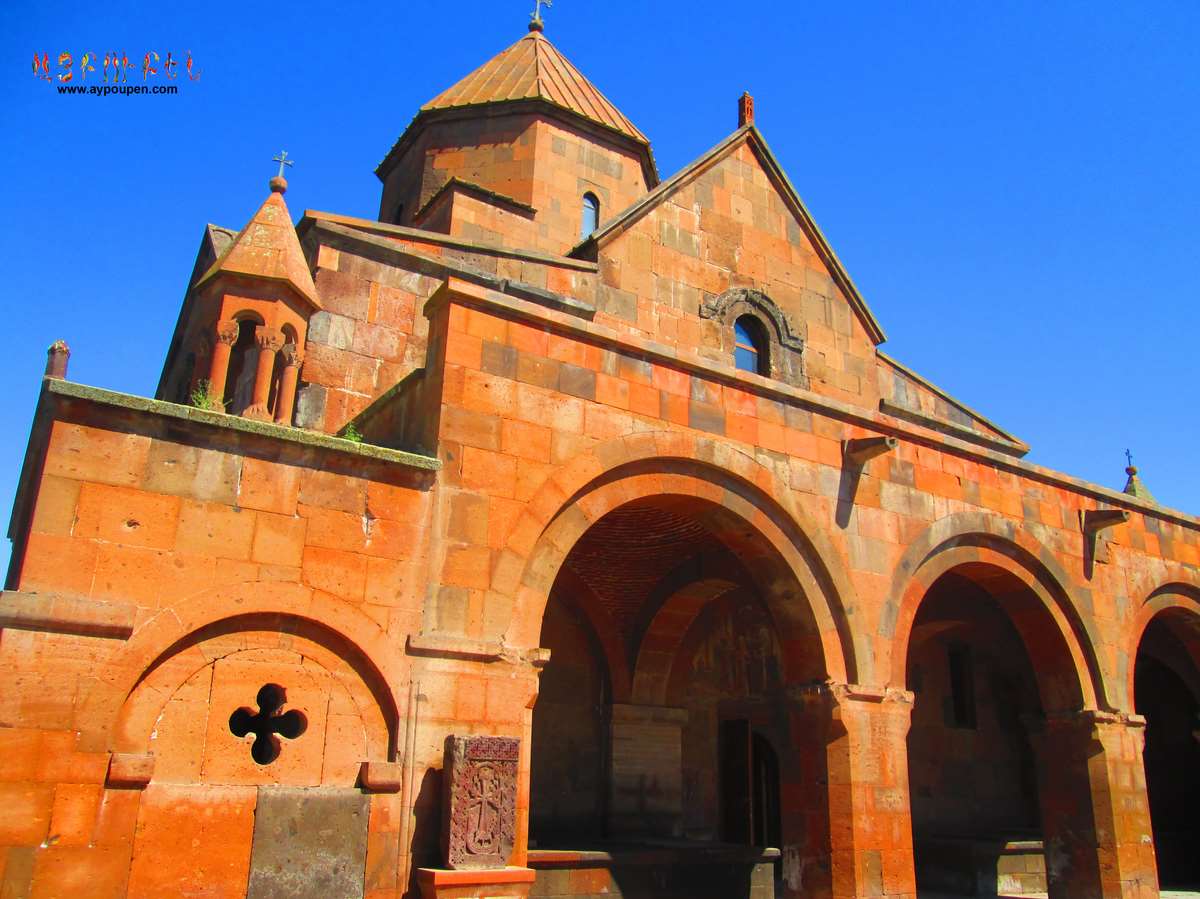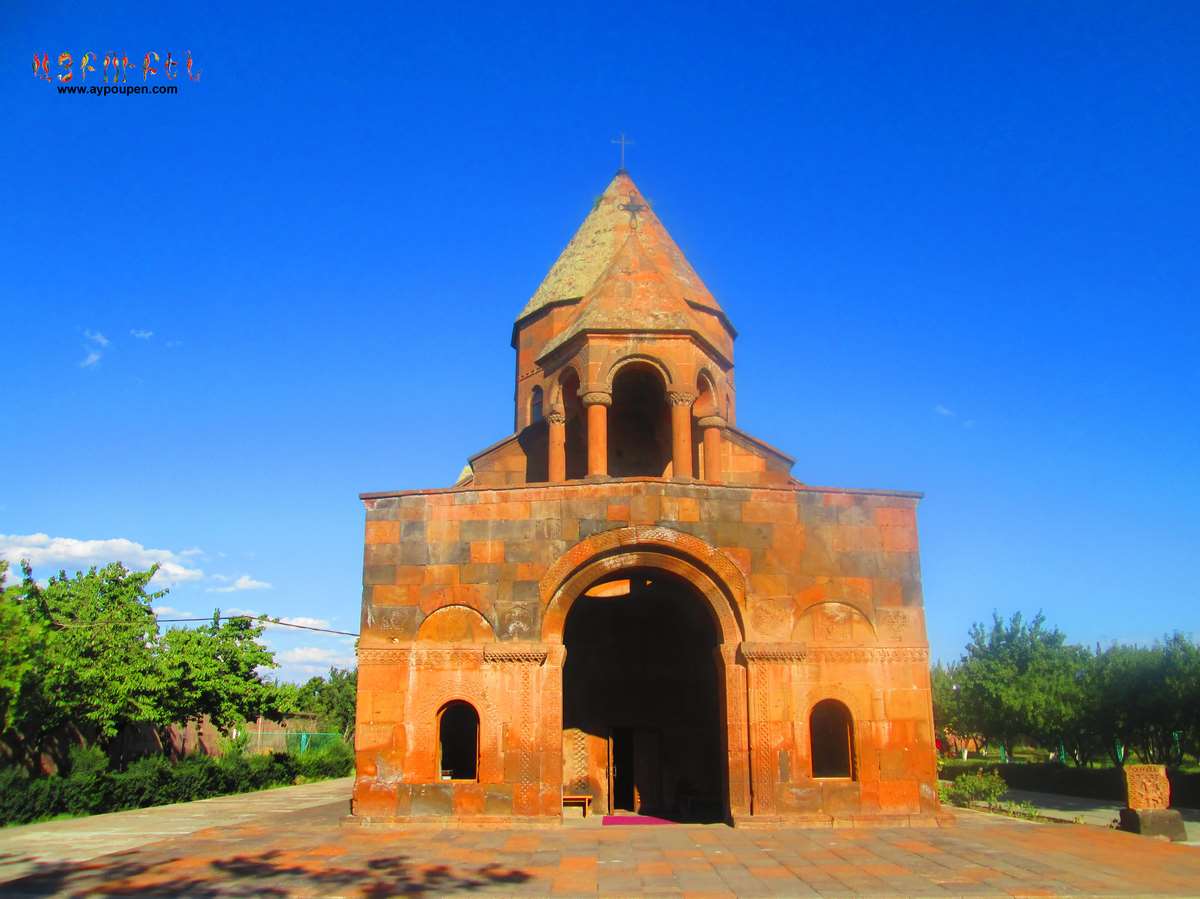Why is Ejmiatsin an iconic cathedral for Christianity?
Ejmiatsin is the residence of the Supreme Catholicos of all Armenians and the center of the Armenian Apostolic Church. It has been an ancient capital of Armenia, originated in the 7th century BC as the town of Vardkesavan. In 140 CE it was renamed Vagharshapat and, after the adoption of Christianity in 301 CE, it became the residence of the Armenian patriarch.
In 344 the town ceased to be the Armenian capital, and in 453 the patriarchal seat had to be moved elsewhere, but in 1441 the Catholicos Kirakos brought back the seat to Vagharshapat, which thereafter remained the home of the “catholicos of all Armenians.” You may find details of the Armenian Orthodox church history here.
The monastery, founded in the 6th century CE and called Echmiadzin from the 10th century, consists of a complex of buildings surrounded by a brick wall 10 meters high; it includes a modern college and seminary.
The present cathedral, on the original church’s site, goes back to the 7th century but was considerably restored after 1441. In the cathedral treasury, the hand (relic) of Saint Grigor Lusavorich (St Gregory the Illuminator) is kept.
The cathedral and churches in Ejmiatsin, along with nearby archaeological remains, were collectively named a UNESCO World Heritage site in 2000.

What is the oldest Cathedral in the world?
The Holy Ejmiadzin Cathedral in Vagharshapat is the first Cathedral in the world and was built by Saint Gregory(The Illuminator) after Armenia became the first nation to adopt Christianity in 301AD. The cathedral was built between 301-303AD, located 23km(14miles) east of Yerevan city, the capital of Armenia.
Why and where St Ejmiatsin Cathedral built?
Ejmiatsin Mother Cathedral is considered one of the earliest Christian buildings in the world. The name Ejmiadzin originated from the Armenian expression իջավ միածինը, meaning the only begotten son descended. According to the legend, Jesus Christ descended from heaven and indicated the spot for the church to be built.
Holy Ejmiatsin Mother Cathedral was built at that site in the 4th century (301-303) after the adoption of Christianity, by order of St Gregory the Illuminator. In the place of the church, there used to be a pagan temple.
The cathedral was built above flowing water which, at present, fills the well located inside the church. The depth of the well has always remained at the same level (7 m) despite anything.
Saint Hripsime Church

St Hripsime Church is located 2 kilometers east of Komitas Square on Mashtots Street and is the first stop by tourists visiting Ejmiatsin from Yerevan.
According to the Armenian Apostolic Church, Hripsime was one of the nuns of a monastery located in ancient Rome. The emperor Diocletian wanted to marry her. All of the nuns, however, decided to run to Armenia and find shelter in Vagharshapat.
The Armenian king Tiridates III, fascinated by the beauty of the same nun Hripsime, also wished to marry her. However, receiving the same answer, the king ordered to kill her and all the other nuns. They were killed one by one.
Three chapels were built in memory of these tragic events: on the grave of St. Hripsime, on the grave of St. Gayane, and the third one at the place where they lived; and one of them, whose name is not known, was killed there.
Hripsime’s martyrdom, as well as those of Gayane and 37 other Roman maidens, precipitated King Tiridates’ madness and later conversion to Christianity.
In the 7the century, St Hripsime Church was built instead of the chapel. The relics of St Hripsime were later canonized and are now kept in a crypt under the altar of the church. Throughout its history, the church has been repeatedly destroyed and rebuilt. At present, it is in excellent condition.
In the early 4th century, Saint Gregory the Illuminator saw a vision in which Christ descended from the heavens, and struck the ground with a golden hammer to level it. In its place, he saw the site where Hripsime was martyred, with a red base symbolizing blood below “columns of clouds, capitals of fire, and on top, a cross of light.”
In the vision, Christ tells him to erect a memorial to Hripsime in the given place.
The monumental exterior of the church is “considered one of the great achievements of medieval Armenian architecture.” It has been described as a “gem of Armenian architecture” and “one of the most complex compositions in Armenian architecture.”
Saint Gayane Church

St. Gayane church is a short walk from the Cathedral of St Echmiadzin. The church is one of the main sanctuaries of the Armenian Apostolic Church.
According to the Armenian Apostolic Church, Gayane was the abbess of the monastery in ancient Rome where Hripsime and the other nuns escaped from.
Saint Gayane Church is a three-nave domed basilica with an octagonal drum resting on four internal pillars that divide the interior of the church into three naves. Three portals lead into the interior of the building.
Yezr Catholicos built it in 630-641 AD instead of the chapel erected on the place of St Gayane Virgin’s and her nuns’ martyrdom, on top of the grave of St Gayane. In 1652 the church underwent capital reconstruction, and in 1683 a gallery was added to its western facade.
Saint Shoghakat Church

St Shoghakat Church is a later monument of Echmiatsin’s architectural complex. The place where the church was built, according to the legend, was occupied by a winepress. The nuns’ shelter, who escaped from Rome, was found here.
St Shoghakat was built in 1694 near St Hripsime Church and sits on the holy site where an unnamed nun following Gayane and Hripsime was martyred.
It was erected from brown tuff. Shoghakat is a domed single-nave basilica with a semi-circular eastern apse flanked on either side by narrow chapels.
The interior of the church is decorated with modest architectural elements and ornaments which are similar to the decorations of St. Hripsime church and Etchmiadzin Cathedral.
As it was mentioned above the third church was built at the place where nuns lived and one of the nuns was killed.
However, Agatangeghos, the historian who left us this legend of the Roman nuns, did not mention the name of the nun who died in the shelter. According to later manuscripts, it was revealed that her name was Mariane.
There is another version of the legend, according to which St. Shoghakat church was built in the place where “a ray of light had fallen” on the dead nuns (literally from Armenian շող (/shogh/ – ray) and կաթ (/kat/ – drop)). So it was believed that not only Mariane but also other nuns were killed here.
Sourp Astvatsatsin (Holy Mother of God)

Walk a bit further along Komitas Park and you will see St Astvatsatsin Church on the left. It is also called the “village” or “peasant” church. Being in the heart of Ejmiatsin, St Astvatsatsin has a magnificent Rococo style altar which is the only of its kind in Armenia.
St Mariam Astvatsatsin Church was built in 1767 during the reign of Simeon Yerevantsi Catholicos. According to the stone inscription, the church was originally made of wood; however, the latter was replaced by stone only a century later.
It is a tri-nave basilica with a roof of two slopes and has three pairs of pillars. One sacristy was built on each side of the eastern main apse.
The main renovation of the church took place in 1986 when a belfry was built from the western side.
Ejmiatsin is a place you want to return over and over again – not only to pray but to see the stunningly beautiful and outstanding churches, not forgetting the legend about the young nuns who were deprived of their lives too soon just because of being Christians.
Photo Gallery of the Cathedral and the 4 churches















